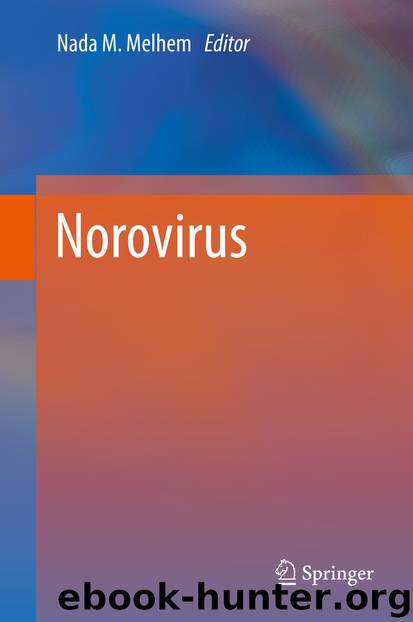Norovirus by Unknown

Author:Unknown
Language: eng
Format: epub
ISBN: 9783030272098
Publisher: Springer International Publishing
Despite their optimal activities in vitro, the therapeutic value of TS inhibitors is deterred by low pharmacokinetics and oral bioavailability. Modification of TS inhibitors to generate bisulphite adducts (e.g. peptidyl aldehydes and α-ketoamides) leads to latent derivatives which become active in the gastrointestinal tract and blood plasma [135]. To further optimise TS inhibitors, novel ester and carbamate prodrug forms of bisulphite adducts were synthesized [136]. The derivatives showed reduced toxicity and improved pharmacokinetics and physicochemical properties in different physiological environments, such as human serum [136]. Further supporting their potential value, these improved TS inhibitors elicited strong inhibition in vitro (0.1–10 μM) and in cell culture (0.01–1 μM).
TS mimics constitute another class of protease inhibitors where the peptidyl recognition element is coupled with a moiety resembling the transition state of the reaction. Their inhibitory activity is due to the irreversible binding of the moiety to the protease in a non-covalent manner [126]. The structural analysis of NS6 in complex with diverse dipeptidyl inhibitors was instrumental to the rational design of optimized compounds with improved activities. One of these new dipeptidyl molecules with high inhibitory activities in cell culture (IC50 of 0.02 μM) and in vitro (IC50 of 0.1 μM) also showed a significant reduction in MNV titres during infections in vivo, encouraging additional studies in this direction [125].
Tripeptide inhibitors were also successfully tested in the control of norovirus infection with some of them exhibiting potent inhibitory activity both in enzymatic assays in vitro and during infections in cells [137]. Though, a major limitation to the therapeutic use of tripeptidyl molecules is the large polar surfaces of these molecules which can compromise membrane permeability and therefore their efficacy at the clinical level [137]. Among these molecules, rupintrivir is a promising tripeptidyl compound which exhibits antinoroviral activity in cell culture tested clinically safe in humans [126, 138]. Rupintrivir showed efficient inhibition of norovirus replication in cell culture (EC50 is 0.3 μM), leading to the complete clearance of HuNoV RNA in replicon-bearing cells [138]. Rupintrivir was originally identified as an irreversible inhibitor of enterovirus 3C proteases. The compound was then tested in Phase I and Phase II trials to the treatment of human rhinovirus infection but no additional studies were performed due to unsatisfactory results [139, 140]. It remains however to be investigated its possible value in the treatment of noroviral disease in vivo. Its poor oral bioavailability suggests that this is not an optimal therapeutic candidate for the clinical treatment of infection, although the promising data obtained in cell culture encourage additional studies to the rational optimization of rupintrivir [138]. A recent study has revealed the rapid selection of resistance mutations in HuNoV NS6pro when replicon-bearing cells are cultivated in the presence of rupintrivir [141]. These findings cast reasonable doubt on the efficacy of therapeutic drugs based on protease inhibitors.
Download
This site does not store any files on its server. We only index and link to content provided by other sites. Please contact the content providers to delete copyright contents if any and email us, we'll remove relevant links or contents immediately.
| Coloring Books for Grown-Ups | Humor |
| Movies | Performing Arts |
| Pop Culture | Puzzles & Games |
| Radio | Sheet Music & Scores |
| Television | Trivia & Fun Facts |
Spell It Out by David Crystal(36082)
Professional Troublemaker by Luvvie Ajayi Jones(29619)
We're Going to Need More Wine by Gabrielle Union(19001)
The Secret History by Donna Tartt(18939)
Cat's cradle by Kurt Vonnegut(15251)
The Goal (Off-Campus #4) by Elle Kennedy(13599)
The Social Justice Warrior Handbook by Lisa De Pasquale(12163)
The Break by Marian Keyes(9334)
Crazy Rich Asians by Kevin Kwan(9216)
The remains of the day by Kazuo Ishiguro(8887)
Thirteen Reasons Why by Jay Asher(8837)
Educated by Tara Westover(7998)
The handmaid's tale by Margaret Atwood(7705)
Giovanni's Room by James Baldwin(7246)
Win Bigly by Scott Adams(7133)
This Is How You Lose Her by Junot Diaz(6830)
The Rosie Project by Graeme Simsion(6286)
Six Wakes by Mur Lafferty(6197)
The Power of Now: A Guide to Spiritual Enlightenment by Eckhart Tolle(5674)
